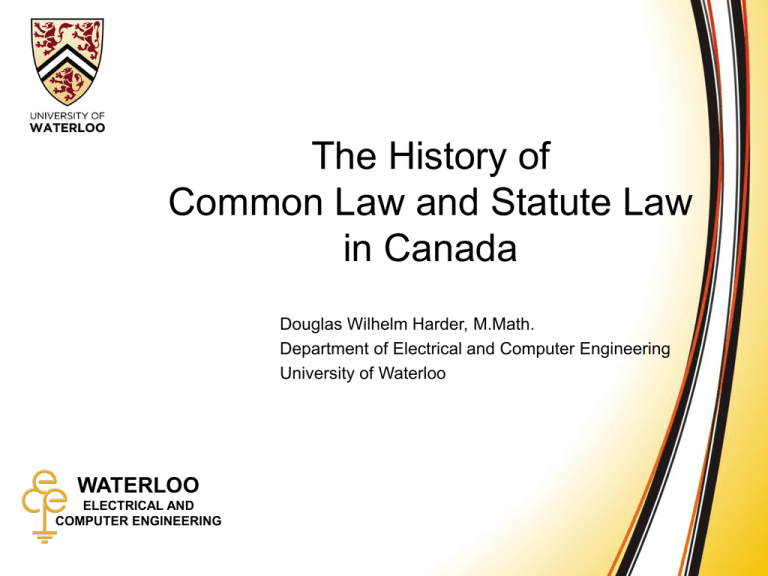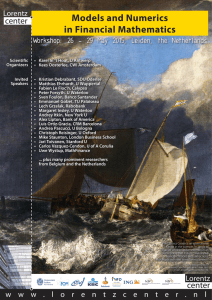
Common Law and Statute Law
The History of
Common Law and Statute Law
in Canada
Douglas Wilhelm Harder, M.Math.
Department of Electrical and Computer Engineering
University of Waterloo
WATERLOO
ELECTRICAL AND
WATERLOO
COMPUTER
ENGINEERING
ELECTRICAL AND
COMPUTER ENGINEERING
1
Common Law and Statute Law
Outline
This talk will cover common law in Canada
–
–
–
–
–
–
The introduction by Henry II
The Supremacy of Parliament
The Constitution Acts of 1867 and 1982
The Charter of Rights and Freedoms
The regulation of professional engineering
Legal basis of contract law and liability in tort
WATERLOO
ELECTRICAL AND
COMPUTER ENGINEERING
2
Common Law and Statute Law
History
In Canada, all regions other than Québec
use common law as the basis for law
It is based on English common law:
– In 1154, King Henry II introduced a unified system of laws to be
common to all his realms
– Judges would resolve disputes on an ad hoc basis
– These decisions were recorded and discussed which founded
rules based on stare decisis from a longer Latin phrase:
“To maintain decisions and to not affect what has been established”
– This is also known as the rule of precedence
• Judges are allowed to modify precedence based on changes to
society and adjust their judgements to suit the particular details
WATERLOO
ELECTRICAL AND
COMPUTER ENGINEERING
3
Common Law and Statute Law
History
King John, the son of Henry II, sealed the Magna Carta
in 1215, sixty-one years after the introduction of a
common law
– At this point, common law was the only law in England
– Magna Carta laid the foundations for Parliament which, of the
centuries, was invested with the power to create laws
WATERLOO
ELECTRICAL AND
COMPUTER ENGINEERING
4
Common Law and Statute Law
History
Parliament became a second source of law:
– A statute or a statute law is law written by the legislative body
– These are usually normalizations or codifications of various
common law precedence
• Statute law takes precedence over common law
• Exceptions exist: the Act of Supremacy of 1534 of King Henry VIII
– In Canada, the federal and provincial legislatures are allowed to
enact statutes
WATERLOO
ELECTRICAL AND
COMPUTER ENGINEERING
5
Common Law and Statute Law
The Canadian Constitution Act 1867
The document which defines the authorities of
Parliament, of the federal government, and the provincial
governments is the Canadian Constitution Act of 1867
– Viewable at http://laws.justice.gc.ca/en/Const/
WATERLOO
ELECTRICAL AND
COMPUTER ENGINEERING
6
Common Law and Statute Law
The Canadian Constitution Act of 1867
The Constitution Act of 1867 states the powers of the
federal and provincial governments
– Section 91 lists twenty-nine areas exclusive to federal legislation
Public debt and property, Trade and commerce, Taxation for federal
purposes, Statistics, Defence, Currency and coinage, Banking,
Weights and measures, Bankruptcy, Patents, Copyrights,
Criminal law
– Section 92 lists sixteen areas exclusive to provincial legislation
Taxation for provincial purposes, Hospitals, Municipal institutions,
Local business and public works, Incorporation, Property and civil
rights, Punishments and “generally all matters of merely local or
private nature within the province”
WATERLOO
ELECTRICAL AND
COMPUTER ENGINEERING
7
Common Law and Statute Law
The Canadian Constitution Act of 1982
The Constitution Act of 1982 introduced the Charter of
Rights and Freedoms
Ron Poling
WATERLOO
ELECTRICAL AND
COMPUTER ENGINEERING
8
Common Law and Statute Law
The Canadian Constitution Act of 1982
The Constitution Act of 1982 states:
Primacy of Constitution of Canada
52. (1) The Constitution of Canada is the supreme law of Canada, and
any law that is inconsistent with the provisions of the Constitution is, to
the extent of the inconsistency, of no force or effect.
The Charter of Rights and Freedom which enshrines:
Fundamental freedoms
2. Everyone has the following fundamental freedoms:
(a) Freedom of conscience and religion;
(b) Freedom of thought, belief, opinion, and expression, including
freedom of the press and other media of communication;
(c) Freedom of peaceful assembly; and
(d) Freedom of association.
WATERLOO
ELECTRICAL AND
COMPUTER ENGINEERING
9
Common Law and Statute Law
Statute Law and Common Law
To demonstrate the relationship between common law
and statute law, consider the case of the Alberta statute
Individual Rights Protection Act
– The Charter of Rights and Freedoms listed specific freedoms
– This act did not extend protection to gays and lesbians whose
rights were violated as a result of their sexual orientation
– The Supreme Court of Canada, on April 2, 1998, observed that
while sexual orientation was not explicitly listed in the Charter, it
is reasonable that it should be included
– The Charter is an example of a statute law; the extension is an
example of common law
WATERLOO
ELECTRICAL AND
COMPUTER ENGINEERING
10
Common Law and Statute Law
Delegation of Authority
Authority may be delegated by either the provincial or
federal governments other bodies
– Provincial governments provide for municipalities which have
their own by-laws, codes, etc.
– Regulatory bodies (such as Professional Engineers Ontario) may
have specific responsibilities
WATERLOO
ELECTRICAL AND
COMPUTER ENGINEERING
11
Common Law and Statute Law
Professional Engineering and the Law
The engineer must be aware of:
– The basis of Law in Canada
– Relevant statutes
– The theory of common law and relevant cases which have
defined precedence
– Additional regulations, standards, codes, by-laws and rules
WATERLOO
ELECTRICAL AND
COMPUTER ENGINEERING
12
Common Law and Statute Law
Professional Engineering and the Law
As a demonstration, the Professional Engineers Act of
Ontario is a statute which defines the practice of
professional engineering provides for:
– The self-regulation of the profession through the Association
– Licences and Certificates of Authorization
– Appropriate committees including the Complaints, Discipline,
and Fees Mediations committees
– Liability insurance
– Discipline and enforcement
WATERLOO
ELECTRICAL AND
COMPUTER ENGINEERING
13
Common Law and Statute Law
Professional Engineering and the Law
Most engineering services are provided under contract
– Contracts are a common-law concept
– It is critical to understand the relevant cases
– Certain aspects are covered by statute:
•
•
•
•
•
Limitations Act (Ontario)
Intellectual property acts (Canada)
Construction Lien Act (Ontario)
Competition Act (Canada)
Statute of Frauds (Ontario)
WATERLOO
ELECTRICAL AND
COMPUTER ENGINEERING
14
Common Law and Statute Law
Professional Engineering and the Law
Engineers must also be aware of the tort of negligence
– Tort is also founded in common law
– It is equally critical to understand the relevant cases
– Again, certain aspects are covered by statute:
• Limitations Act (Ontario)
• Workplace Safety and Insurance Act (Ontario)
– I.e., worker’s compensation
WATERLOO
ELECTRICAL AND
COMPUTER ENGINEERING
15
Common Law and Statute Law
Summary
This talk covered a history of common law in Canada
–
–
–
–
–
–
The introduction by Henry II
The Supremacy of Parliament
The Constitution Acts of 1867 and 1982
The Charter of Rights and Freedoms
The regulation of professional engineering
Legal basis of contract law and liability in tort
WATERLOO
ELECTRICAL AND
COMPUTER ENGINEERING
16
Common Law and Statute Law
References
[1] Gordon C. Andrews, Canadian Professional Engineering and GeosciencePractice and Ethics, Nelson Education Ltd., 2009.
[2] Professional Engineers Act General R.R.O. 1990, Regulation 941.
http://www.e-laws.gov.on.ca/html/regs/english/elaws_regs_900941_e.htm
[3] Professional Engineers Act General R.R.O. 1990, Regulation 941.
http://www.e-laws.gov.on.ca/html/regs/english/elaws_regs_900941_e.htm
WATERLOO
ELECTRICAL AND
COMPUTER ENGINEERING
17
Common Law and Statute Law
Copyright and Disclaimer
•
•
•
•
•
These slides are Copyright © 2010 by Douglas Wilhelm Harder.
All rights reserved.
These slides are made publicly available on the web for anyone to use
No warranty is given that any information in these slides is correct
The use of these slides in studying for the PPE is fully at your own risk
If you choose to use them, or a part thereof, for a course at another
institution, I ask only three things:
– That you inform me that you are using the slides,
– That you acknowledge my work, and
– That you alert me of any mistakes which I made or changes which you make,
and allow me the option of incorporating such changes (with an
acknowledgment) in my set of slides
Sincerely,
WATERLOO
ELECTRICAL AND
COMPUTER ENGINEERING
Douglas Wilhelm Harder, MMath
dwharder@alumni.uwaterloo.ca
18


